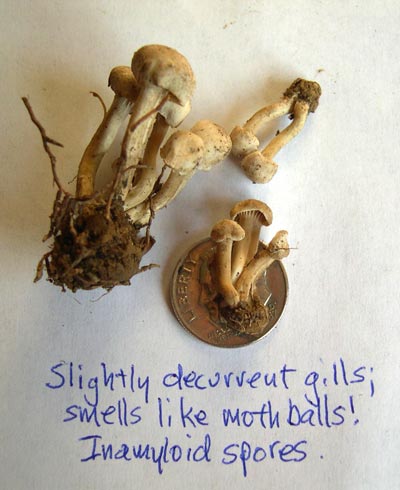Camarophyllopsis foetens
Hot on the Trail of the “Mothball Fungus,”
or Adventures in Identifying Mushrooms
Putting names to mushrooms can be an art as well as a science. Like a master birder who can name a bird with only a fleeting glimpse, mushroomers, too, can get a feel or “gestalt” for a particular species, or genus of mushrooms. Although mushrooms are certainly not as behaviorally varied as are birds, they do have unique attributes for our human senses: not only shape and size and color, but smell and taste and feel. It is rare indeed that the birder has its subject in hand for a definitive ID, but it is common to have one’s mushroom up close and personal during the ID process, and this allows for a more intimate perusal.
California mushroomers are blessed with excellent regional field guides and keys. What cannot be confirmed in the hand can always be put under the microscope, but most mushroom IDs take place at the macroscopic level. In an experienced group with a lot of mushrooms to identify, many of the most obvious IDs take place quickly. But once you have plowed through your pile of familiar mushrooms, you are left with the difficult to ID groups and the oddballs that defy categorization. This is where not only skill, but a sense of curiosity and exploration is invaluable; a certain amount of obsessive behavior doesn’t hurt, either.
We had a chance to test our taxonomy skills at the All California Club Foray in Mendocino County in January 2007. Despite rather adverse dry and cold conditions, we were presented with a surprising number of fungi. Our stalwart crew of identifiers gamely plowed through the knowns, and then, one by one, began to tackle the more difficult to ID groups. I grit my teeth and keyed Russulas and Tricholomas, John Brown jumped into the Inocybe pile, and Doug Smith, Phil Carpenter, and Henry Young did a little bit of everything. Taking photographs and reading descriptions, our progress was slow but steady, and we soon had named mushrooms stacked on paper plates on every available surface.
But our most intriguing find was a mushroom that defied easy description. Its size was tiny, its features obscure, its color non-descript, but 'oooooo' that smell. It reeked of naphthalene or mothballs in your Grandma’s closet where she stored her woolens. It was distinctive, to say the least. So distinctive, that despite our difficulties in putting a name on it, we persevered. Eventually, everyone in our tiny lab was working on this one mushroom.

© photo by Debbie Viess
By Saturday evening, Dr. Terry Henkel had joined our merry band, and we worked through and named a number of interesting specimens. But we kept puzzling over our little oddball fungus. Buff with a hint of yellow, growing in clusters, slightly decurrent gills; we had nuthin’. In hopes of finding us a suitable genus, Terry led us through Largent’s Book VI, Modern Genera, quizzing us on characters and going through an ever-narrowing process of elimination. The mushroom had the vague look of a waxy cap (that gestalt thing again), but the caps were so tiny, no one could get a finger underneath to feel the gills.
We were desperate for an ID. We went with non-waxy gills in the key, and had a moment of excitement when we thought that perhaps we had found our genus in Pseudoomphalina.
I felt like a detective hot on the trail of a suspect, but just as we seemed to be closing in, disaster struck! The inamyloid spores from our specimen did not match the description. We were back to square one, and coming hard up against midnight. “OK, that’s it for me,” I said as I retreated to my cabin. But I hadn’t given up completely.
Sometimes, your ability to identify a mushroom is only as good as your keys. What if this mushroom simply wasn’t in the books and keys that we had at hand? That smell was so distinctive, I was sure that we could find a name. I carefully packed it into my tackle box, and brought it down to the Bay Area.
After a couple of distracting days at home, I went to my refrigerator and there it was, slightly desiccated, a little more gray, but still in good shape. I photographed it, and stuck it in the dehydrator. Fortunately Christian Schwarz, an up and coming amateur mycologist from Santa Cruz, had already written up a description. With a dried and still plenty stinky specimen in hand, and a digital photo on my computer, I contacted my secret weapon: Dr. Dennis Desjardin, a San Francisco State University mycology professor and mycena specialist, with expertise extending to many other types of small fungi found in California. I sent him an email, with photos and a description, and I hoped against hope that he would be able to help.
Bingo! He immediately identified it as Camarophyllopsis foetens, and told me that it was a rare fungus. With the camarophyllus part of the name, it must have had waxy gills after all. For those who are a little rusty on their latin, foetens means foul smelling, and indeed it was this unique attribute that clinched the ID. So we all came away happy. The mushroom didn’t die in vain (it was named and honored and preserved for posterity); we had a great time pursuing its identity, and Dennis got a fabulous new specimen for the SFSU Herbarium.
Heck, this little guy even makes its own version of insect repellant, to keep those nasty herbarium bugs away. How cool is that?
Just another way to have fun with fungus,
© Debbie Viess

 back to top
back to top